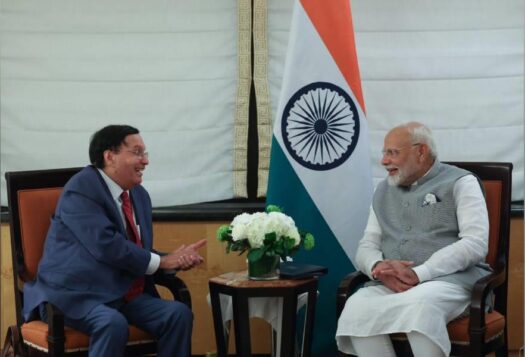
Much has been said and written since Indian defense minister Manohar Parrikar aired his “personal” opinion on India’s nuclear doctrine at a book release event in Delhi earlier this month. While acknowledging that it was his own thinking, he said, “If a written down strategy exists or you take a stand on a nuclear aspect, I think you are actually giving away your strength in nuclear…Why should I bind myself [to a no first use policy]? I should say I am a responsible nuclear power and I will not use it irresponsibly.”
A number of issues arise from his statements, and they merit consideration. This is not to evaluate the merits or de-merits of India’s no first use (NFU) policy, but to illustrate why Parrikar’s remarks were not exceptional, why such off-the-cuff statements could still be cause for alarm, and the nature of ambiguity in India’s nuclear doctrine and its impact on deterrence stability in South Asia.
First, Parrikar is not the first official representative to enunciate an interpretation of India’s NFU policy that does not appear to mirror the Indian nuclear doctrine. In a speech to the National Defence College on October 21, 2010, India’s National Security Adviser Shivshankar Menon said that the Indian nuclear doctrine advocates “no first use against non-nuclear weapons states.” This raised the suspicion that first use was an option against nuclear weapons states (NWS).
At the time, Menon’s remarks created quite a rumpus. Some wondered whether his words signaled a shift in India’s declaratory policy from nuclear deterrence to nuclear war-fighting. Several observers noted that this was quite possibly a typographical error. Regardless, such slips by those closely associated with the nuclear establishment have important consequences for signaling and the public’s understanding of India’s nuclear policy.
The second issue, therefore, is one of unintended ambiguity and the damage it can cause. To be sure, Parrikar, as defense minister, should not be airing his personal views, especially if they diverge from the doctrine. This undermines the cause of ambiguity in the doctrine and deterrence in the region.
The draft Indian nuclear doctrine was promulgated by the National Security Advisory Board (NSAB) in 1999, followed by a much shorter Cabinet Committee on Security (CSS) press statement, with some caveats, in 2003. Although the CCS statement is popularly understood to be the official nuclear doctrine, analysts tend to refer to either the 1999 draft nuclear doctrine or the CCS statement, or both, in their readings of India’s nuclear posture and strategy, which can lead to confusion.
A recent example of this is in the chapter titled “Why India Pledges No First Use of Nuclear Weapons” in Shivshankar Menon’s book, Choices: Inside the making of India’s Foreign Policy (Penguin, 2016). Menon cites the following excerpt:
“…India will not be the first to initiate a nuclear strike, but will respond with punitive retaliation should deterrence fail.” [emphasis added]
At another point in the chapter, Menon says, “The doctrine speaks of punitive retaliation.”
The excerpt and Menon’s conclusion are drawn from the 1999 draft nuclear doctrine. The 2003 press statement says, “Nuclear retaliation to a first strike will be massive and designed to inflict unacceptable damage.” [emphasis added]
The fact that a former National Security Adviser cites the 1999 draft doctrine, which was disowned by the government, is significant because it suggests a more fluid reading of the two doctrines than is usually believed.
What is not clear from either doctrine is whether the drafters of the 2003 statement meant “massive retaliation” as an all-or-nothing strategy or as inflicting unacceptable damage on the adversary through retaliation that is “massive” in nature, as decided by the Political Council. This second interpretation would allow for a range of flexible, proportional options determined on a case-by-case basis.
Third, Parrikar’s statement is about a nuclear doctrine that contains various caveats already. Whether the existence of these caveats augments ambiguity or diminishes the credibility of India’s nuclear deterrent is moot, as is the value of statements such as Parrikar’s.
Take, for example, the NFU as enunciated in the 2003 statement:
“…in the event of a major attack against India, or Indian forces anywhere, by biological or chemical weapons, India will retain the option of retaliating with nuclear weapons.”
This essentially constitutes a first strike, yet it can be read in several ways.
First, if NFU implies deterrence, the caveats cited above can be interpreted as aggression. Second, the statement shows that the Indian stance, caveats and all, is actually quite clear, and Pakistan merely uses the “lack of credibility” around India’s NFU to justify its nuclear build-up. Third, one could interpret this caveat as a deliberate Indian scheme to push Pakistan to squander precious and limited resources on its nuclear capabilities rather than conventional forces. The problem with this line of reasoning is that Pakistan’s resultant over-dependence on nuclear weapons acts counter to Indian interests. In all three readings, the ambiguity surrounding the NFU seems to be producing diminishing returns.
Many of the above issues were addressed in 2012 by the Institute of Peace of Conflict Studies’ civil society effort, which this author participated in, to bring out an alternative nuclear doctrine. This, however, was outside the officialdom. Vice Admiral (Retd) Vijay Shankar, former Commander-in-Chief of the Strategic Forces Command in India’s Nuclear Command Authority (NCA), writes that there have been two reviews of the Indian nuclear doctrine over the past decade. However, the general lack of public knowledge about whether official periodic reviews are even taking place creates an environment where off-hand remarks such as Parrikar’s only add to the seeming lack of credibility of the Indian doctrine.
Editor’s note: This piece is part of a two-part series examining the Indian defense minister’s recent comments questioning India’s no first use policy, and assessing whether ambiguity in a state’s nuclear doctrine provides deterrence options, what this would mean when applied to the India-Pakistan relationship, and what impact it will have. Read the entire series here.
***
Image: Senior Master Sgt. Adrian Cadiz, Flickr


